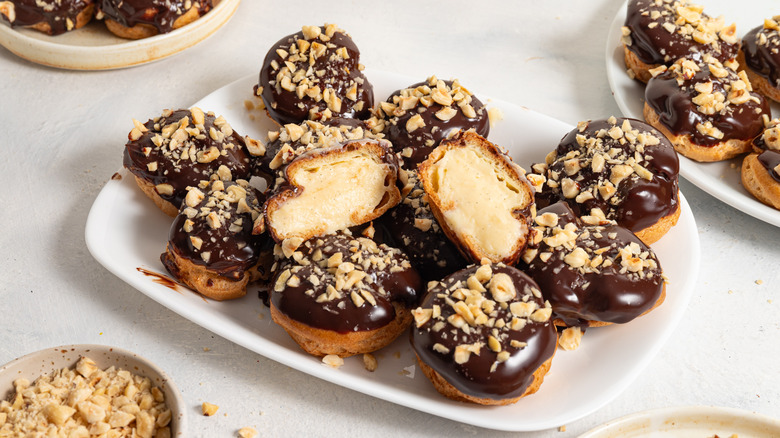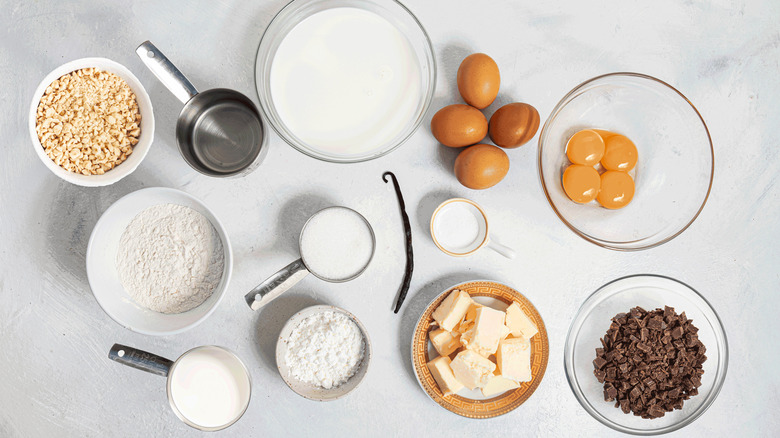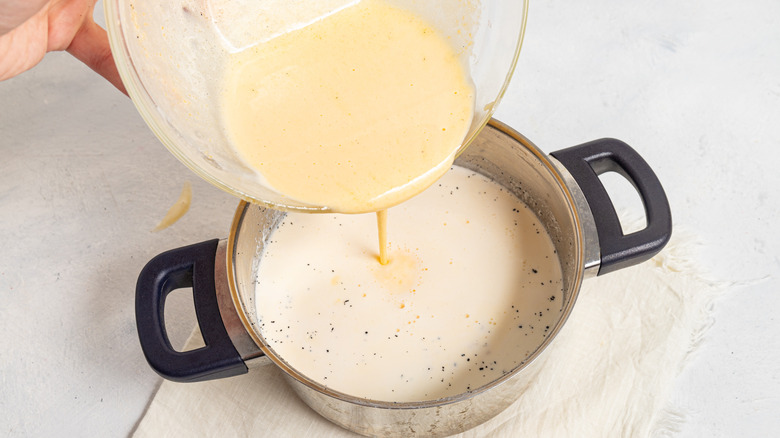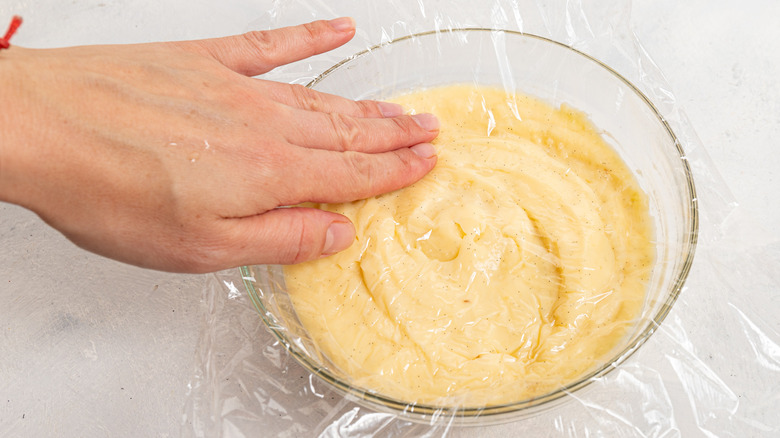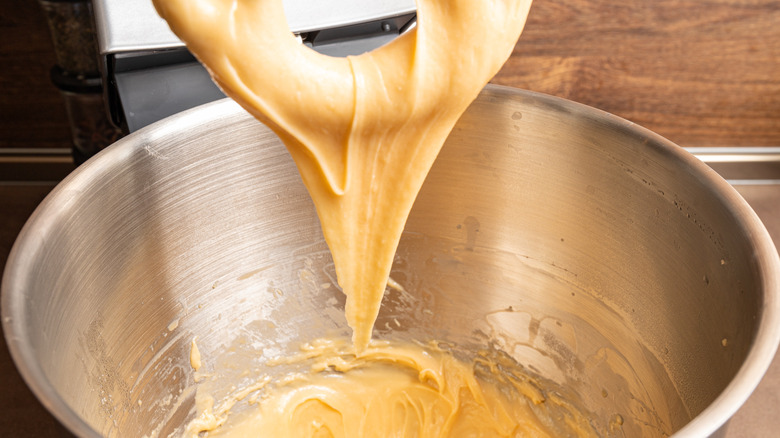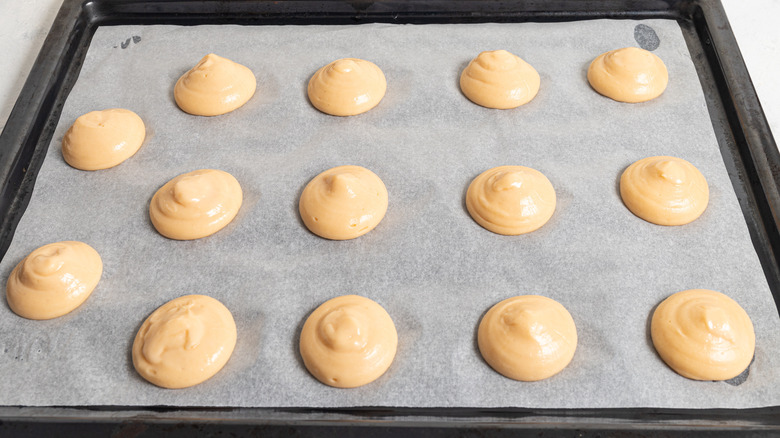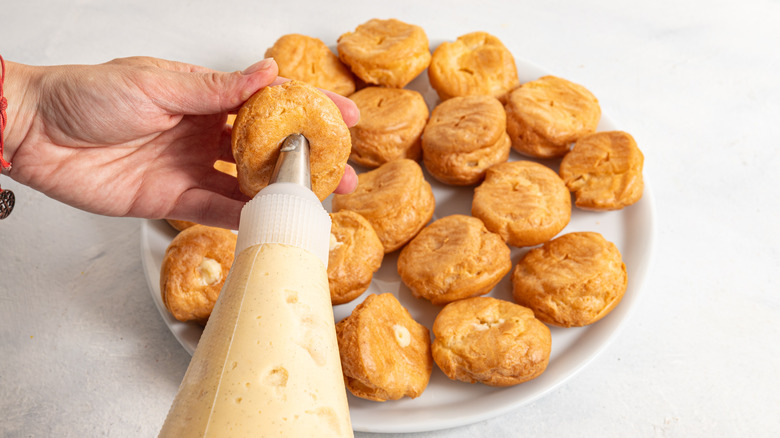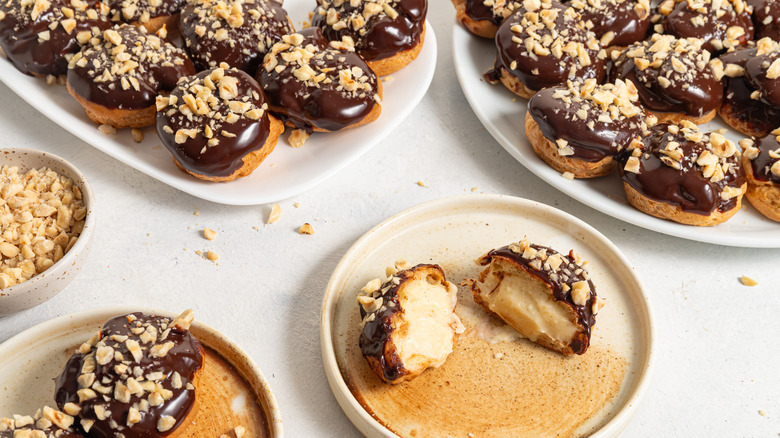Chocolate Hazelnut Profiteroles Recipe
There are two types of people in this world: those who make their own pastries and those who leave it to professionals. While some treats seem to require years in pastry school to perfect, with a bit of patience and attentiveness, you too can become someone who makes their sweets from scratch. Food Republic recipe developer Milena Manolova brings us this classic profiteroles recipe, outlining the careful craft of these delightfully airy pastries.
You'll want to set aside a period of uninterrupted time to make these, as the multi-step process does not welcome multitasking. Of course, a break away from responsibilities to dedicate yourself to perfecting the art of a timeless French pastry is a worthwhile reason to push everything else aside. Manolova shares, "I love this recipe for a few reasons: The light and airy pastry created by the choux dough, the combination of textures, and the crispiness of the pastry shell with the creamy filling all create a contrast that adds to the overall enjoyment." Plus, she highlights that the dessert is "super versatile," as home pastry cooks can switch up the filling and toppings as they please.
Gather the ingredients for this classic profiteroles recipe
For the cream filling, you'll need egg yolks, sugar, cornstarch, salt, milk, vanilla bean, and butter. Next, for the pâte à choux (the pastry dough surrounding the cream), you'll need water, butter, sugar, salt, all-purpose flour, and whole eggs. Manolova notes that you can also swap ½ of the water for milk if you want a richer result. Finally, to make chocolate ganache and assemble the profiteroles, get out some heavy cream and chop some bittersweet chocolate and hazelnuts.
"Vanilla is the main flavor profile in this recipe, so using a good quality vanilla bean for the pastry cream is important," Manolova highlights, adding, "I would avoid vanilla extract, since we want to see those little black seeds in the cream."
Prep the pastry cream
Prep your workspace by preheating the oven to 400 F convection/fan, or 425 F if your oven uses a conventional setting. Next, line a baking tray with parchment paper and set it aside. From here, the first step is to make the pastry cream for the filling. Add the egg yolks, sugar, cornstarch, and salt to a medium-sized bowl and whisk the contents until the mixture is homogeneous. Set this to the side while you work on the other component of the cream.
Place a saucepan on the stovetop and pour in the milk. On a cutting board, carefully slice the vanilla bean along its length and scrape out the seeds. Toss the pod and all the seeds into the saucepan with the milk. Heat the burner to medium and stir the milk constantly to prevent it from sticking to the bottom of the pan and burning. When it comes to a boil, take the pan off the burner and discard the vanilla bean pod — the milk has now been infused with vanilla flavor.
Now, pour about ½ cup of the warm milk into the bowl with the egg yolk mixture, whisking quickly so the eggs don't start to scramble from the heat. Pour the egg mixture into the saucepan with the milk and place it on the burner once again. Cook the milk and egg mixture for 2-3 minutes, stirring the whole time, until it thickens. Then, take the pan off the heat and stir in the butter until the contents are smooth.
Strain and chill the pastry cream
Place a fine sieve over a bowl and strain the pastry cream through it to discard any lumps. Cover the bowl of pastry cream with plastic wrap, ensuring that it touches the surface of the cream. Manolova explains that this trick prevents a skin film from forming over the top of the cream. Transfer the bowl to the fridge for a minimum of 3 hours for it to set.
If you want to split up the recipe process, Manolova notes that "the pastry cream can be made ahead of time and kept in the fridge for up to 2 days."
Meanwhile, make the pastry dough
While the cream filling sets in the fridge, you can work on the pastry. Get a clean saucepan and add the water, butter, sugar, and salt to it, then place it on a burner over medium heat. In a small bowl, whisk the 4 whole eggs until the mixture is homogeneous.
When the contents of the saucepan begin to bubble and the butter is melted, dump all the flour in at once. Stir the mixture right away, and keep mixing it until it begins to thicken and form a thin layer on the bottom of the pan. Manolova notes the importance of cooking the dough sufficiently, explaining that "not cooking it enough will make the dough more wet and cause the puffs to not bake correctly, lose their shape, and have the wrong texture."
At this point, take the pan off the heat and pour the contents into the bowl of a stand mixer with a paddle attachment. Mix the dough until it has cooled down a bit, then slowly pour in the whisked eggs in 3-4 parts as the mixer keeps running. You may not need the last part of the egg mixture, depending on the consistency of the batter. Manolova instructs that you'll know the dough is ready when it comes off the paddle attachment in a V-shape, as pictured.
Pipe out the pastry, and bake
When the dough reaches the optimal consistency, transfer it to a piping bag. Cut off the tip so the opening is about ¾ inch wide, and carefully pipe out the dough into "walnut-size blobs," leaving about 2 inches between each, on your parchment-lined baking sheet. If some of the blobs have a peaked top, simply wet your finger and use it smooth the top down.
Your oven should be at temperature by now, so transfer the baking sheet to the middle rack and bake the dough for 10 minutes. Then, decrease the heat to 320 F and bake the puffs for another 12 minutes or until they are a golden brown color. Turn off the oven and take out the tray. Now, use a toothpick or skewer to poke a small hole through the bottom of every puff. Place them back on the sheet with the hole facing upward and transfer the tray back to the oven for 10 minutes. Although the oven is off, the residual heat will dry out the inside of the puffs once the steam is released through the hole. After 10 minutes, take them out of the oven and let the dough fully cool.
You might be tempted to make the pâte à choux ahead of time, but Manolova notes that "it's best to use the baked puffs as soon as they cool off from baking. The puffs can change texture pretty quickly and lose their crispiness, becoming softer."
Fill the puffs with pastry cream
If your pastry cream has been in the fridge for at least 3 hours, take it out and discard the plastic wrap. Manolova warns not to whisk it once it is set, or the thick and creamy texture will be compromised. Transfer the cream into a piping bag with a round nozzle tip about ¼ inch wide. One by one, fill the pastries with cream through the poked hole.
If this step requires more precision than you care for, Manolova says, "Another way of filling the profiteroles is by slicing them as you would a burger bun and filling them with ice cream." She also notes that you could use "chocolate pastry cream, ice cream, whipped cream and fruits, mascarpone with fruit sauce, and many more" combinations to load up the pastry.
Coat the profiteroles with chocolate ganache and nuts, then serve
Sure, you could bite right into a profiterole at this point, but you've come this far and the last step is definitely worth it. Place a small saucepan on the stovetop and heat the heavy cream. Add the chopped chocolate to a bowl and pour the warm cream over top. Let the contents sit for a few minutes so the chocolate starts to melt, then whisk until the mixture is smooth.
One by one, dip the profiteroles into the ganache and transfer them to a plate. If ganache isn't your thing, Manolova notes various toppings to try: "They can be drizzled with chocolate sauce, homemade salted caramel spread, or powdered sugar." Sprinkle them all with chopped hazelnuts and serve up these decadent homemade classic profiteroles.
You'll want to prepare this recipe when you're feeding a few other people with a sweet tooth, as Manolova says that "profiteroles are best eaten the day they are made. They can last in the fridge for up to 2 days in a sealed container." Per Manolova's recommendation, serve your freshly filled profiteroles with a cup of tea or coffee, and enjoy.
Chocolate Hazelnut Profiteroles Recipe
A true labor of love, these profiteroles are filled with fluffy vanilla bean pastry cream and topped with silky chocolate ganache.
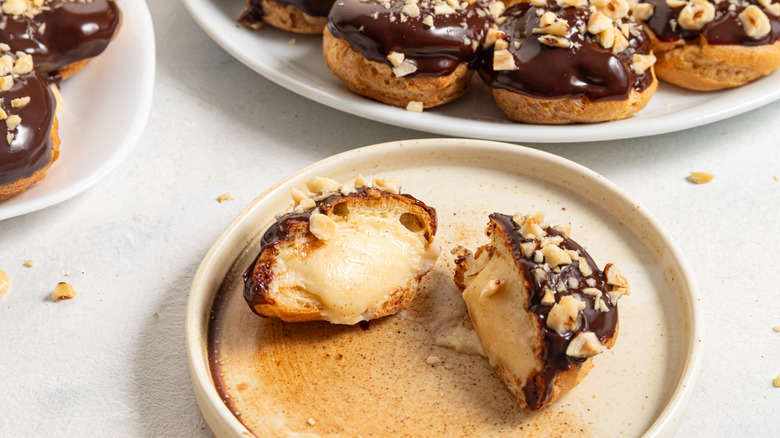
Ingredients
- For the pastry cream
- 4 egg yolks
- ½ cup sugar
- 3 tablespoons cornstarch
- ½ teaspoon salt
- 2 cups milk
- 1 vanilla bean
- 3 tablespoons butter
- For the pâte à choux
- 1 cup water
- ½ cup butter
- 2 teaspoons sugar
- ½ teaspoon salt
- 1 cup all-purpose flour
- 4 whole eggs
- For the ganache and assembly
- ¾ cup heavy cream
- 7 ounces bittersweet chocolate, chopped
- 5 ounces hazelnuts, chopped
Directions
- Preheat the oven to 400 F convection/fan (425 F if using a conventional setting) and line a baking tray with parchment paper.
- Combine egg yolks, ½ cup sugar, cornstarch, and ½ teaspoon salt in a bowl. Mix until homogeneous and set aside.
- Add the milk to a saucepan.
- Slice the vanilla bean lengthwise and scrape out the seeds. Add both the pod and seeds to the saucepan of milk.
- Cook the milk on medium heat, stirring frequently to prevent it from burning. Once the milk has come to a boil, remove it from the heat and discard the vanilla bean.
- Pour a bit of the heated milk (about ½ cup) into the egg yolk mixture, whisking to prevent the eggs from cooking.
- Transfer the tempered egg yolk mixture to the saucepan of milk and return it to medium heat. Cook, stirring constantly, until it thickens, about 2-3 minutes.
- Remove the pan from the heat and add 3 tablespoons butter. Stir until smooth.
- Strain the cream through a sieve placed over a bowl to collect any lumps. Cover the pastry cream with plastic wrap (it should directly touch the surface of the cream to stop a skin from forming). Place in the fridge for at least 3 hours to set. (Once set, don't whisk again, as it will lose its thickness.)
- Meanwhile, make the pâte à choux. Add water, ½ cup butter, 2 teaspoons sugar, and ½ teaspoon salt to a clean saucepan over medium heat.
- Meanwhile, whisk the other 4 eggs in a separate bowl.
- Once the pâte à choux mixture starts boiling and the butter is fully melted, add the flour all at once, cooking and stirring constantly until the mixture starts to thicken and forms a thin layer on the bottom of the saucepan.
- Remove from the heat and transfer to the bowl of a stand mixer with the paddle attachment. Mix the dough until it cools slightly.
- Add the beaten eggs to the dough, still mixing, in 3-4 parts. You might not need all of the eggs, so check the dough consistency before adding the last part. The dough is ready when it slowly falls down from the paddle attachment in a V-shape.
- Once the dough is ready, transfer it to a piping bag. Cut the tip of the bag about ¾ inch wide.
- Pipe walnut-size blobs of pâte à choux, about 2 inches apart, onto the prepared baking sheet. If the blobs have peaks, gently smooth them down with a wet finger.
- Bake on the middle rack for 10 minutes, then reduce the heat to 320 F and bake for 12 more minutes, or until golden brown.
- When ready, turn off the oven, remove the baking sheet, and make small holes in the bottom of each profiterole with a toothpick or skewer before placing them back on the tray with the holes facing up. Bake for 10 more minutes so the profiteroles can release the steam and dry out from the inside with the residual heat.
- Remove profiteroles from the oven and let cool completely.
- Meanwhile, place the set pastry cream into a piping bag with a round piping tip nozzle, about ¼ inch wide.
- Fill each cooled pastry with the cream.
- To make the chocolate ganache, heat up the heavy cream in a small saucepan. Place the chopped chocolate and a bowl, and once the cream is warm, pour it over the chocolate. Let sit for a few minutes to melt, then whisk until smooth.
- Dip each profiterole into the chocolate ganache, place on a plate, and sprinkle with chopped hazelnuts. Enjoy right away.
Nutrition
| Calories per Serving | 150 |
| Total Fat | 11.0 g |
| Saturated Fat | 5.2 g |
| Trans Fat | 0.1 g |
| Cholesterol | 51.6 mg |
| Total Carbohydrates | 11.7 g |
| Dietary Fiber | 0.8 g |
| Total Sugars | 7.3 g |
| Sodium | 83.2 mg |
| Protein | 2.7 g |

